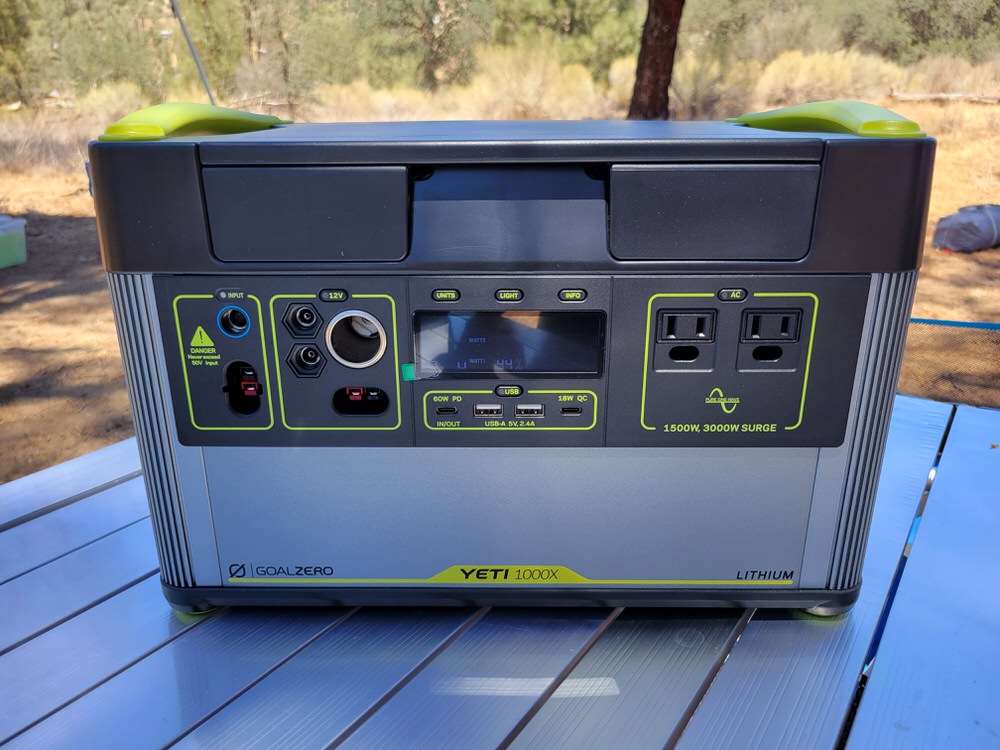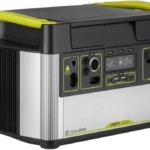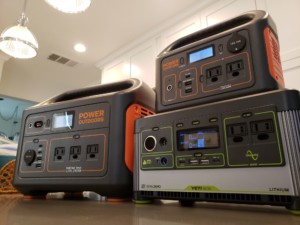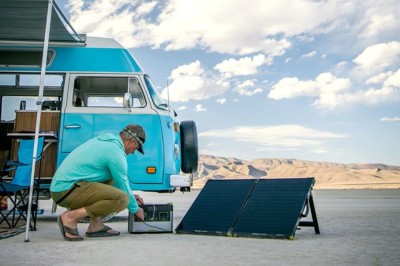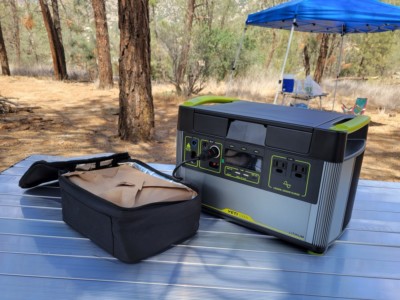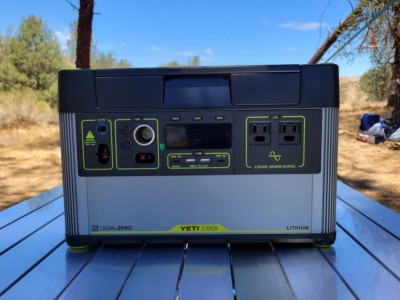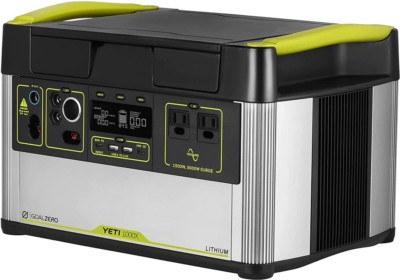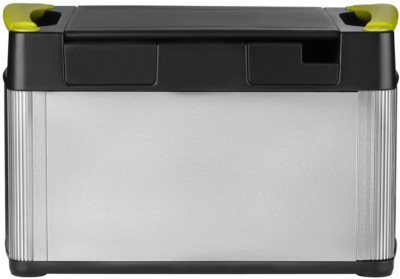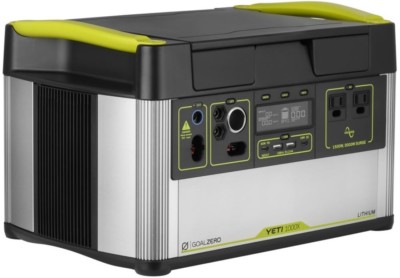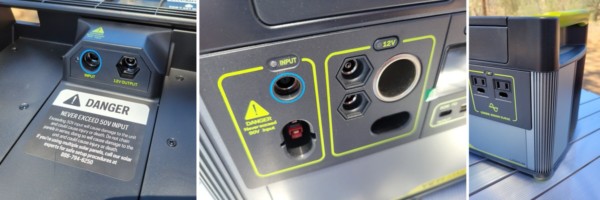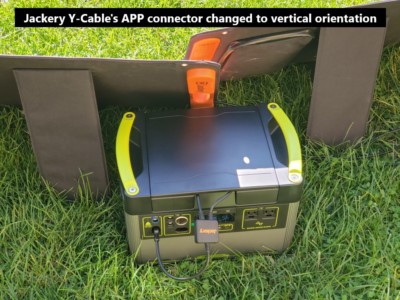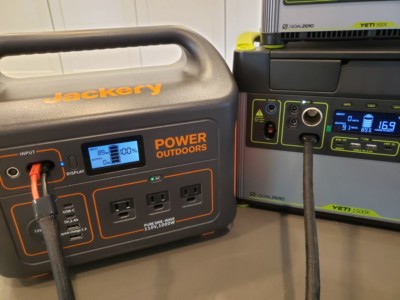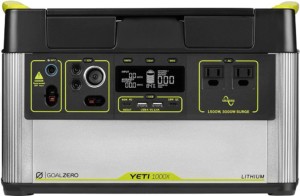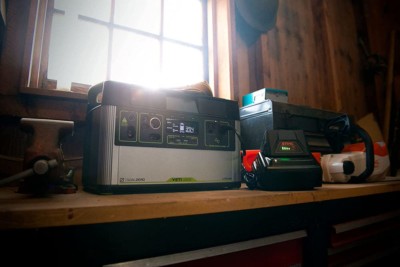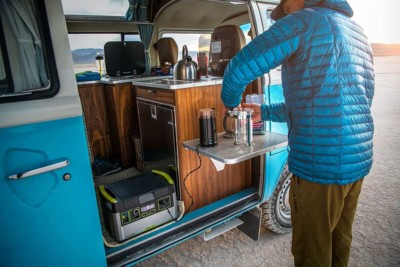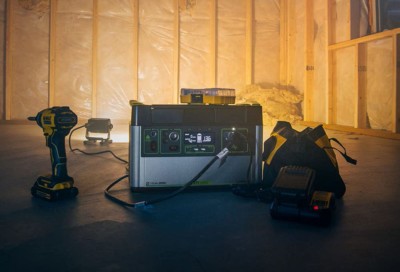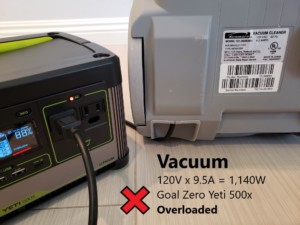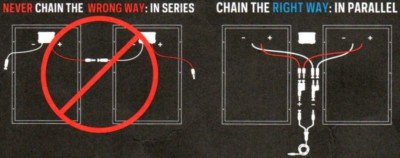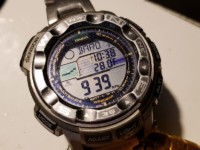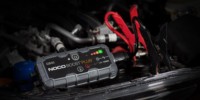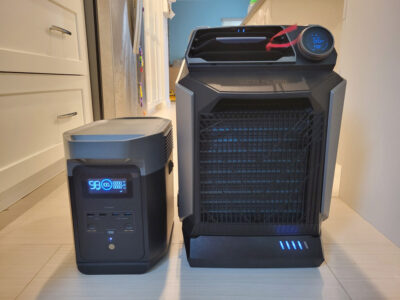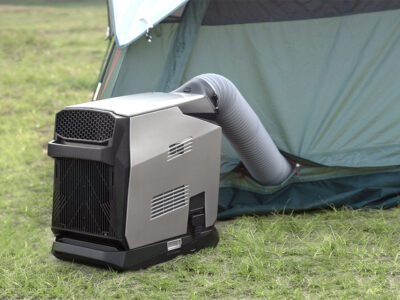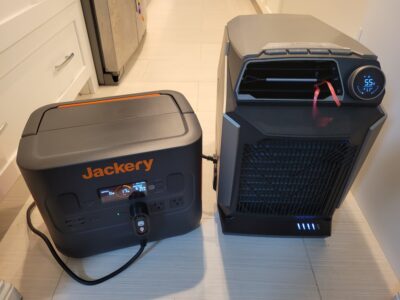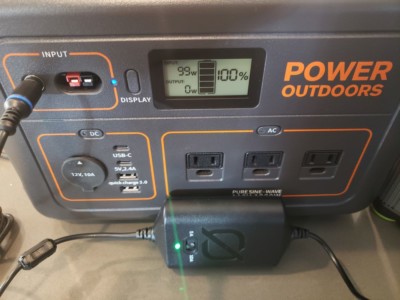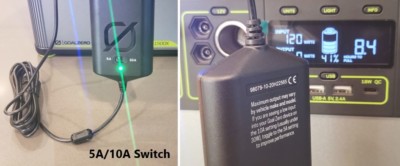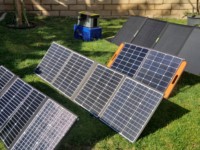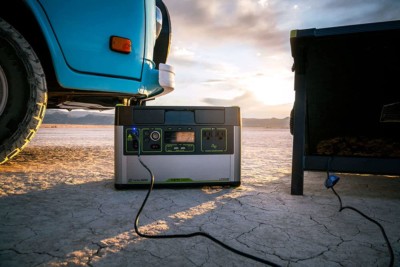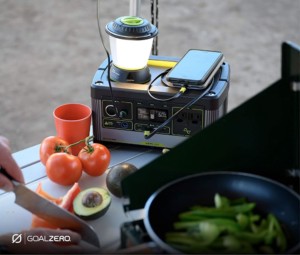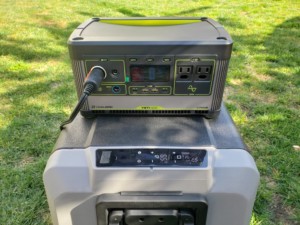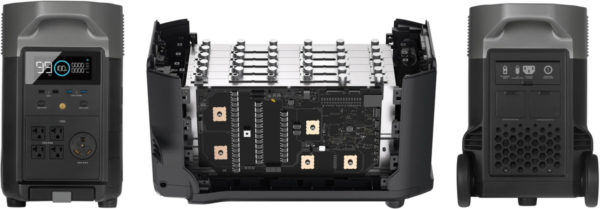Goal Zero Yeti 1000x
Pros
- High-quality BMS with LG battery cells
- Vast ecosystem of accessories, expansions, integrations
- High max input (150W or 600W)
- Tough exterior
- Industry leader & Safety record
Cons
- High price
- Ugly top compartment
- No mobile app control/monitoring
- Long auto-shutoff timer
- Battery not user replaceable
Contents
Right Balance of Power and Weight
Half a year ago, I purchased the eye-opening Goal Zero Yeti 1500x after having fallen in love with the Yeti 500x. The latter has remained my all-time favorite power station for its beautifully compact design and reliability. The Jackery Explorer 1000 with its just-the-right-size battery also had been one of my favorites for its lower cost and weight, but lacks the extensive ecosystem of accessories that Goal Zero has. The good news is, the long-awaited Goal Zero Yeti 1000x (Goal Zero | Amazon) was finally launched on June 8, 2021, and to my pleasant surprise, it can be expanded just like its larger Yeti siblings. Would it be compelling enough to replace my Jackery Explorer 1000 with? To find out, I borrowed one of my lucky friends’ Yeti 1000x for a week.
The Goal Zero Yeti 1000x hits the sweet spot with enough battery capacity and lower weight while having the ability to integrate into the company’s vast ecosystem of products and accessories.
There are three, main reasons I had bought portable battery stations and solar panels for:
- Power outages
- Emergency preparation
- Recreation
Wildfires and hurricanes have increasingly become common in the past few years’ news cycles, and in California, there had been multiple times where electric companies simply shut down services during high risk conditions to minimize the risk of starting a fire. In fact, just 7 months ago, our family had to evacuate when a blaze ravaged nearby!
Between natural disasters, power outages, working from home amidst the COVID-19 pandemic, and seeking to bring electronic conveniences (like CPAP medical machines) when out camping, sales for gas generators, batteries, and solar panels had seen an uptick in demand.
What Will Be Covered Here
My friends, family, and I had learned so much using products from a variety of brands like Suaoki, Rockpals/Paxcess, nrgGo, Jackery, and Goal Zero, a common question I would often get is: “What power generator is best for my situation?” This article will go over many of the basics in the TIPS section, including:
- Gas/propane generators vs battery power stations (aka “solar generators”)
- What I think about various power station brands
- How to determine what battery capacity or solar panel would work for you
- How I got each brand’s products to work with one another
But first, let’s dive into the Goal Zero Yeti 1000x review. Note: I borrowed this power station from my friend for only a week, but learned enough to see how similar it was to my Yeti 1500x.
In A Nutshell
Goal Zero’s Yeti 500x is one of my all-time, favorite power stations with its beautifully compact design and reliability. The newer Yeti 1500x brought with it new capabilities and an expanded ecosystem of available accessories that really opened my eyes as to why Goal Zero has been a favorite with those living off-the-grid. The company’s newest, Yeti 1000x, extends many of the larger sibling’s capabilities into a smaller package, including:
- Charging input of 600W max from up to 4 solar panels
- Powering your home with a Yeti Home Integration Kit
- Battery capacity expansion with Yeti Expansion Tanks
- Charging via Yeti Link Vehicle Integration Kit
- Charging other Yeti power stations via the Anderson Powerpole (APP) or 12V car ports
Continuing to stay true to the company’s infamous safety focus, the Yeti 1000x contains 983 Wh of top-tier LG battery cells, a high-quality Battery Management System, Pure-Sine Wave AC output for sensitive electronics, and the ability to scale the system as large or small as needed with its large portfolio of products, integrations, and accessories. The last part is key: many of the other manufacturers (Jackery included, my other favorite) do not have that kind of a collection.
The 1000x’s dimensions are nearly identical to the Yeti 1000 Lithium predecessor, somehow manages to be 8.3 lbs lighter (due in part to shedding 62 Wh capacity), and has a more pleasing color scheme. Its AC inverter capability, however, has remained the same at 1,500W (with 3,000W peak). Both share a similar-looking exterior, but the inside of the Yeti X now houses a built-in MPPT controller for more efficient charging and an increased input limit of 600W (360W on its predecessor). Furthermore, the regulated 8mm 150W and USB-C PD 60W ports can be used at the same time to charge the Yeti at a faster 210W. One could easily expand the 1000x’s capacity with Yeti Tank Expansion Batteries — a capability that many of Goal Zero’s competitors lack.
For an industry leader, however, there are some things I do not like. Goal Zero’s products command a price premium, yet, like Apple’s infamous sales strategy, do not have basic accessories included (like a car or solar charging cable). Was it to encourage buyers to only buy what they need (and thus minimize waste) or to make extra profit on accessory sales? Furthermore, the 1000x’s Anderson INPUT port (APP) is arranged vertically when most of the solar panels from other brands connect horizontally. I previously questioned this move as an attempt to upsell Goal Zero-exclusive cables, but then I realized that it may be to differentiate the vertical and horizontal APP ports: one for input and the other for output. You can purchase a third-party APP extension cable (like iGreely) to freely switch the orientation for use with other brands’ products (a guide on how to do this will be written soon.) Another disappointment is the inability to have its battery be consumer replaceable like the Yeti 1400 Lithium.
Something not immediately noticeable was how well-designed Goal Zero’s cables were for forming a tight, weatherproof seal that also prevented accidental disconnects. This detail was easily overlooked until I tried to figure out how to get different manufacturers’ products to work with one another. Also not well-known in my circle of friends was the 12V cigarette car charger (Goal Zero/Amazon) that should deserve much more praise than the company had given because it could regenerate a battery at a whopping 120W in vehicles that support 10A! (It also worked with my Jackery batteries.) For the fastest charging, the Yeti X series accepts the astoundingly high-performance, pricey, 600W power supply.
Overall, I am very happy with the way the power station works, its expansion options, thoughtful design with top-notch components, and the safety reputation the company has been known for. The Yeti 500x still is my favorite, lightweight battery, but the Yeti 1000x far surpasses it by unlocking nearly the full ecosystem of the Goal Zero product family without being as heavy as its Yeti 1500x sibling. In other words, the Yeti 1000x hits the sweet spot with enough battery capacity and lower weight while having the ability to integrate into the company’s vast ecosystem of products and accessories.
Tip: A battery power station like this one cannot be used to jump start a car. Instead, I suggest getting a small, portable one specifically made for that, such as my favorite: NOCO Genius Boost Car Jump Starter (Lithium Battery).
Note: Goal Zero renamed its Anderson Powerpole (APP) ports in Nov 2020 to High Power Port (HPP) to avoid trademark infringement with its inventor: Anderson Power Products. This is only a name change as the connector works the same way as before. For the purpose of avoiding confusion, I will interchangeably refer to the port as HPP or APP.
What’s Good? What’s Bad?
Pros
- Lithium-ion NMC cells made by LG (a top-notch, Tier 1 battery manufacturer)
- Very professional, tough look with a pleasing color scheme, though I’m not a fan of the odd-looking top storage compartment that breaks the clean lines of the Yeti 500x
- Aluminum exterior helps protect against bumps and battery puncture
- Given that Li-Ion batteries become more volatile as capacity increases, this added protection is important
- Environmentally friendlier than hard plastic
- Vertical, rounded edge grilles provide extra grip, heat dissipation, and act like bumpers
- Rounded corners are less likely to shatter than sharp edges
- Jackery, Rockpals, and other brands I had used were made of hard plastic shell that may be more prone to cracking and overheating
- Brushless fan on each side for cooling
- Aluminum exterior helps protect against bumps and battery puncture
- 983 Wh battery capacity (31.7 lbs @ 15.3″ x 10.2″ x 9.9″)
- Comparisons
- 40.0 lbs @ 15.3″ x 10.1″ x 9.3″ / Goal Zero Yeti 1000 Lithium
- 30.9lbs @ 15.7″ x 8.3″ x 10.6″ / Ecoflow Delta 1300
- 22.1 lbs @ 13.1″ x 9.2″ x 11.1″ / Jackery Explorer 1000
- Roughly equivalent to a 265,675 mAh 3.7V power bank (or 91,018 mAh 10.8V)
- Capacity to power a 30″ LCD monitor and Mini PC for 10-14 hours, a Toshiba 50″ Fire TV for almost 9 hours
- Capacity can be extended by connecting Yeti Tank Expansion Batteries
- Comparisons
- Pure-Sine Wave AC Inverter capable of continuous 1,500W power (and unmatched 3,000W peak) — See USAGE section
- Clean power for sensitive electronics
- Less heat
- Note: Some manufacturers claim to be Pure-Sine when they are actually Modified or Square Waves
- High-quality BMS (Battery Management System) for safety
- Provides built-in overload, overcharge (automatic stop when the device is full), and short-circuit protection
- Regulated Output ports
- Can power AC and DC (USB/12V Car adapter) at the same time
- Common, supported devices: laptop, tablet, phone, light, fan, CPAP, projector, TV, refrigerator, camera, pressure cooker, miter saw
- Multiple charging options with up to a whopping 600W!
- Can be used while charging
- Although this is supported, doing so could hurt the battery’s lifetime
- MPPT (Maximum Power Point Tracking) solar charge controller/regulator
- Smarter, faster/more efficient, and costlier than PWM (Pulse Width Modulation). Older Yeti 1000 Li uses PWM
- Suitable for larger systems
- Can parallel-connect up to 4 solar panels with a combiner cable (not included) for faster charging (8mm-to-HPP 4x or HPP-to-HPP 4x cable)
- 12V Car Charger (60W/120W) (Goal Zero | Amazon)
- Directly from car battery with Yeti Link Vehicle Integration Kit (454W-750W)
- Can be used while charging
- Large ecosystem of accessories and interoperable products (batteries, solar panels, integration kits, cables, etc.)
- This gives the Yeti 1000x its BIGGEST advantage over the competition
- Accessories are very well-made with solid connections that help weatherproof and prevent accidental disconnects
- APP and 12V cigarette ports can be used to charge other Yeti power stations, but using them with other brands is not supported by the company
- Was able to charge Yeti 500x, Jackery Explorer 1000 and Explorer 300
- This method would combine both batteries’ capacities (ie. Yeti 1000x + 500x = 983 Wh + 505 Wh = approx. 1,488 Wh. Keep in mind there is some power loss during conversion/transfer)
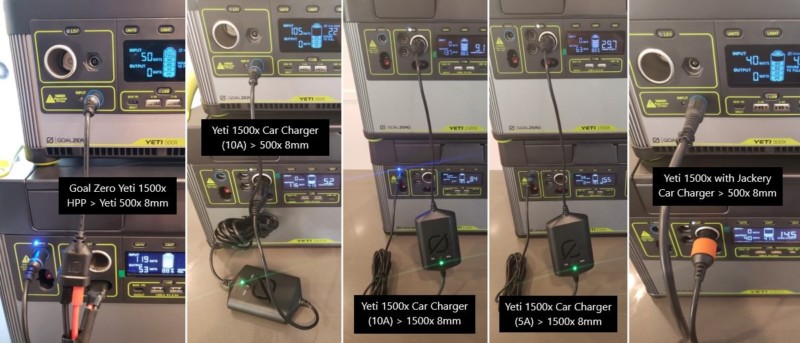
Yeti 1500x used to charge other batteries. (Sorry, I forgot to take pictures of the 1000x doing the same)
- Carry handles on each side with a comfortable, non-slip grip
- Top of Yeti 1000x has a covered storage compartment
- No other tested power station has that
- Top of Yeti 1000x has a covered storage compartment
- Excellent, informative LCD with LED backlight
- Total power coming in (via solar panel, 12V car port, or wall charger)
- Capacity left (as a percentage)
- Total power (AC and DC combined) being used
- Suaoki G500 (an unreliable product I do NOT recommend) displays the Wattage separately for DC and AC, which I prefer
- Estimated hours
- When Input > Output, shows time to full
- When Output > Input, shows time to empty
- Units can be toggled between “Volts” and for Output: “Amps”, “Watts”, “Watt-hours”
- Press Units + Light buttons for 3 secs to display Yeti’s firmware version
- Info button did nothing. Customer service said that, like the 1500x’s, “more features are coming” that will utilize it, presumably via a firmware update
- Bottom is well-protected by neon green, non-slip feet
- Manual: Unusually detailed with some helpful tips
- Great technical support
- Good customer service, though I was very impressed by the sizably positive stories from Jackery’s customers
- 2 year warranty
- American company founded with humanitarian goals
- Hopefully, they will not deviate from the “Don’t be evil” mantra like Google famously did
Cons
- No Smartphone app-based remote control, power usage monitoring, battery optimization, notifications, and firmware upgrade via WiFi
- Only Yeti 1500x and higher has this function
- Battery capacity decreased by 62 Wh over its Yeti 1000 Lithium predecessor, but sheds 8.3 lbs in weight
- Heavy at 31.7 lbs due to the use of aluminum housing instead of plastic
- Battery not replaceable like the older Yeti 1400 Lithium
- Leads to landfill/environmental waste. Please recycle responsibly!
- Goal Zero asked to “stay tuned” when I inquired about user-friendly battery replacement options for the Yeti 1500x. I hope that this will become available for the Yeti 1000x as well
- Premium pricing
- Anderson Powerpole (APP/High Power Port) input port is vertically arranged when most solar panels from other brands are horizontal
- Requires a Goal Zero cable to work, though I found a great alternative that allows you to re-arrange the connectors’ orientation to fit any Anderson connector: iGreely APP Extension Cable
- Initially thought that changing the APP orientation was a ploy for Goal Zero to sell additional cables, but it was also likely a way for the product to differentiate the ports as Input (vertical) or Output (horizontal) to prevent someone from connecting accessories incorrectly
Tip: It is possible to get multiple companies’ products (battery power stations and solar panels) to work with one another once you understand the different connector types, such as Anderson APP, MC4, 8mm, and so on. In one test, I had simultaneously connected solar panels by Goal Zero, Jackery, Suaoki, and Paxcess to the Yeti 1500x’s Anderson port to collect energy from all four! Although I did not test this with the Yeti 1000x, it should work the same way. Expect an article about interconnectivity soon.
- No secure way to prevent theft of power station (besides chaining the removable carry handles)
- Not waterproof. Keep it away from water splashes, rain, and pool!
- Lithium and fire or water can cause serious damage or injury!
- Display, though quite informative, does not show separate power consumption for DC and AC
- LCD is unreadable without LED backlight
- No built-in light or LED bar to illuminate your area or blink “S.O.S.”, the international distress signal
- No cable accessories or carry bag included besides the 120W wall charger (100-240V, 16V @ 7.5A)
- Competitors often throw in cables for charging via solar or car cigarette socket, and sometimes a small case to hold them
- Automatic shutoff when idle is an unusually long 30 hours
- Ensures Yeti does not turn off when a low-powered device (like medical CPAP) is used overnight
- Could unexpectedly drain battery from 100% to 86% with nothing connected (because AC inverter uses 7W on its own)
- Power buttons can be accidentally turned on/off with a short press (ie. while packing away your camping gear)
- Requiring a 2-second press to turn on or off would minimize unintended button presses
- No master button to turn off ALL outputs at the same time
- Other auto off times
- Jackery Explorer 1000 & 500: 12 hrs (when less than 10W used)
- Rockpals 500W: 10 hrs
- Multiple fans turn on during high peak and can be too noisy for some
Ports
All output ports are Regulated.
Input
- (2) 8mm (1 front, 1 storage compartment– but only ONE can be used at a time)
- 14-50V, max 10A. Do NOT use a power source that exceeds the max Voltage or Amperage!
- Max input: 150W
- Jackery Explorer 1000, Rockpals 500W: max 200W
- Included power supply outputs 120W
- Only one of the 8mm ports can receive power
- Having both ports receive different Voltage levels could have one drive power to — and damage — the other
- Can be used for solar charging
- Depending on the solar panel’s connector, an 8mm adapter may be needed (ie. 8mm-to-HPP on Amazon/Goal Zero)
- Connect 2+ solar panels in PARALLEL with an 8mm-to-HPP 4x Combiner Cable (max 150W)
- TIP: Goal Zero and Jackery both use an 8mm connector, but they are not completely interchangeable
- Jackery’s cable can somewhat be used with one or both GZ ports, but not the other way around. You will have to cut part of the cable’s plastic barrel to make it work with both companies’ products
CAUTION: Do NOT daisy-chain 2+ solar panels in sequence/series as that can output more than 50V combined and damage the power station! Connect them in PARALLEL with a Y-branch or Combiner cable instead! See “Solar Panel – Warning” section.
- (1) High Power Port (HPP aka Anderson/APP)
- (1) USB-C PD 60W – Both for input/output
- Powerful enough to charge a 60W laptop (ie. 13″ MacBook Pro)
- Can charge concurrently with the 8mm port for a total of 210W of input
- Both ports are on a separate charge control circuit. There is no overload risk for using them concurrently
Note: If power is sent to both the 8mm and HPP ports, only the one with the highest input will be used.
Output
- (2) AC with 3 prongs (120V, 60Hz, 2.5A) – Pure Sine Wave
- Inverter handles a continuous 1,500W, peaking at 3,000W — See USAGE section
- Note: Uses 7W with nothing plugged in
- (1) HPP (Anderson/APP) (12V, max 15A, max 180W) — Yeti 1500x maxes at 30A for 360W
- (1) Cigarette socket (12V, max 15A, max 180W)
- (2) 6mm (12V, max 10A, max 120W)
- Single, compact 12V port to universally charge electronics with different connectors using a variety of adapters
- Allows GZ to create 12V products to use 6mm instead of the bulky cigarette socket
- (1) USB-C PD (5-20V, max 3A, max 60W) – Both for input/output
- (2) USB-A (5V, max 2.4A, max 12W)
- (1) USB-C (5-12V, max 3A, max 18W) – QuickCharge
- (1) Expansion Module Port (in storage compartment) for use with GZ expansion modules
Usage
- To turn ON or OFF the DC (12V Car/6mm/HPP, USB) or AC outputs, press the corresponding button (“12V”, “USB”, “AC”)
- Note: This single-press (without hold) can lead to accidental power on/off, unknowingly draining the battery until idle auto-off kicks in
- Turn off any output ports (AC/DC) that are not being used in order to conserve power
- Without anything plugged in, the AC inverter still draws 7W on its own
- Li-ion NMC batteries have 500 charge cycles before capacity drops to about 80% from when they were new
- Product could, in theory, be charged up to 2,000 cycles — about 20-25% of total capacity is lost every 500 cycle
- To prolong the battery lifetime while in storage, keep the battery fully charged every 3-6 months
- Or, according to customer support, keep it plugged in when not in use and discharge it to 50% every 3-4 months
- The charging controller automatically gets disabled once the battery is full
- NOT using the battery for a very long time can actually hurt its lifetime
- There is no “memory effect” in this station’s battery
- Note: It is better to NOT let it completely drain before recharging
- Battery, like all Li-ion, slowly drains over time even when station is powered off
- Could take 1-1.5 years to go from full to empty
- Or, according to customer support, keep it plugged in when not in use and discharge it to 50% every 3-4 months
CAUTION: Lithium-ion (LiFePO4 and NMC) batteries do NOT like to remain discharged at 0% for prolonged periods of time. If you let your battery stay at 0% for too long, you may not be able to charge it again without specialized equipment.
- Battery is NOT replaceable, although it appears that Goal Zero is working on a solution it previously had available for its older Yeti 1400 Lithium
- Keep a car cigarette lighter with the power station — you could plug it into its 12V DC socket for starting a camp fire
- Unlike LiFePO4 batteries, NMC can operate only in temperatures between 32-104F (0-40C). Both are Lithium-ion chemistries
- GZ’s Battery Management System (BMS) limits:
- Recharging in temps outside of 32-113F
- Outputting power in temps outside of 14-149F
- GZ’s Battery Management System (BMS) limits:
Continuous vs Peak Output
It is important to understand the difference between Watts and Watt-Hours. How much power is used or produced is measured in Watts, and how much energy a battery can store is calculated in Watt-Hours. See the “Calculations” section below for more details.
How much energy a battery can store is measured in Wh (Watt-hours), and how much power is used or produced in W (Watts).
- AC Inverter: Converts battery (DC) power into AC
- Yeti 1000x provides 1,500W continuous output with a 3,000W peak
- Peak/Surge (Starting): Nearly every device initially draws extra power to turn on. The highest amount it pulls is the Peak. As long as that number is below 3,000W, it can be STARTED. Examples…
- Turns on OK (PEAK under 3,000W):
- Freezer starts at 400W (peak), runs at 150W once on
- Coffee maker starts at 1,400W (peak), runs at 800W once on
- Will NOT turn on (PEAK over 3,000W):
- Home AC starts at 4,000W (peak), runs at 1,000W once on
- Turns on OK (PEAK under 3,000W):
Most devices power on at a higher (Peak) wattage than when they are already on (Continuous). Therefore, if its peak exceeds the power station’s max, it may not be able to start
- Continuous Output (Running): Once devices are on, as long as they keep drawing less than 1,500W total, they will stay ON until the battery runs out
- CONTINUES running (under 1,500W)
- 100W TV + 60W laptop = 160W
- COULD STOP running (over 1,500W)
- Temporary overdrawing beyond 1,500W for a few seconds is okay. A quality BMS will protectively shut down the battery if the surge does not end after a while. Regularly going over for a prolonged time can ruin the battery in the long run
- 1,300W machine (2,100W peak) + 300W appliance (500W peak) = 1,600W. Probably will stay on for a short period
- Add 1,000W mower (1,400W peak) = 2,600W. Battery will definitely shut down
- CONTINUES running (under 1,500W)
Goal Zero Yeti Comparison
| Product | Battery Capacity | AC Inverter (Continuous) | AC Inverter (Surge) | Max Input | Expandable | Charge Controller | WiFi, BT | Weight | Dimensions (inches) |
|---|---|---|---|---|---|---|---|---|---|
| Yeti 200x | 187Wh NMC | 120W | 200W | 120W | No | MPPT | No | 5 lbs | 7.9 x 5.1 x 5.1 |
| Yeti 500x | 505Wh NMC | 300W | 1,200W | 120W | No | MPPT | No | 12.9 lbs | 7.5 x 11.3 x 5.8 |
| Yeti 1000c | 983Wh NMC | 1,200W | 2,400W | 300W | No | MPPT | No | 31.7 lbs | 15.3 x 10.2 x 9.9 |
| Yeti 1000 Lithium | 1,045Wh NMC | 1,500W | 3,000W | 360W | Yes. Yeti Link, MPPT | PWM | No | 40 lbs | 15.3 x 10.1 x 9.3 |
| Yeti 1000x | 983Wh NMC | 1,500W | 3,000W | 600W | Yes. Yeti Link | MPPT | No | 31.7 lbs | 15.3 x 10.2 x 9.9 |
| Yeti 1500x | 1,516Wh NMC | 2,000W | 3,500W | 600W | Yes. Yeti Link | MPPT | WiFi, BT | 45.6 lbs | 15.3 x 10.2 x 10.4 |
| Yeti 3000x | 3,032Wh NMC | 2,000W | 3,500W | 600W | Yes. Yeti Link | MPPT | WiFi, BT | 69.8 lbs | 15.3 x 10.2 x 13.6 |
| Yeti 6000x | 6,010Wh NMC | 2,000W | 3,500W | 600W | Yes. Yeti Link | MPPT | WiFi, BT | 106 lbs | 15.3 x 10.1 x 17 |
Solar Panel – Warning
This power station can be charged with one or more solar panels as described in the “Ports > Input” section. There are SOME PRECAUTIONS you must take to minimize battery damage and/or injury to life/property:
- Never exceed the maximum Voltage (V) or Amperage (A) of the power station’s charging port
- If you want to use 2+ solar panels to charge faster:
- Do not mix them with different V or A as the output might get reduced (less energy generated)
- Do not daisy-chain them in sequence/series as that can exceed the power station’s maximum V or A
- Always connect them in PARALLEL with a Y-branch or Combiner cable
- Keep the battery out of direct sunlight while charging. You may have to use an extension cable to keep it in the shade
Wondering what size solar panel to get? See the “Calculations” section below.
Calculations – Size & Time
What size battery should you get? How long will it power your fridge for? How long will it take to recharge? The below calculations can help answer those questions and are rough ESTIMATES as conditions, battery quality, and age can vary.
Time to Charge Battery
- Calc: Hours to charge battery = Battery capacity (Wh) / Input Wattage
- Note: As battery approaches 75% full, the input charge will increasingly be slowed down to prevent overcharging
- AC Wall: 120W @ 8.2 hrs [983 Wh / 120W]
- Goal Zero 12V Car Charger (Goal Zero/Amazon)
- 60W @ 16.4 hrs (5A setting) / 120W @ 8.2 hrs (10A setting, if car supports it)
- Most other manufacturers only charge up to 60W. So, 120W with the Goal Zero is game-changing for me and comes highly recommended
Charge Time with Solar
- Calc: Hours to charge battery = Battery capacity (Wh) / (Panel Wattage x [0.5 or 0.75])
- In a perfect lab environment, solar panels charge at the listed wattage
- Expect to only receive 50-75% on a good, sunny day (ie. 75W – 113W for a 150W panel), depending on panel’s age, component quality, and weather
- 200W solar panel: as fast as 6.6 hours [983Wh / (200W x 0.75)]
- Tips
- Keep charging even when overcast as the panels will STILL collect energy
- Underproduction: If a 200W panel is not making enough (ie. only 50W) due to bad conditions, adding extra ones (ie. two more 200W) can generate a higher, combined output (ie. 50W + 110W from the two panels = 160W total)
- Overproduction: If the panels make more (ie. 400W) than the maximum the power station charge port can take (ie. 120W), only the max (ie. 120W) will go through
Watts Used/Produced
- Calc: Watts used or produced by device = Voltage x Amperage
- Vacuum with 120V @ 9.5A uses 1,140W
- Solar panel with 12V @ 10A can produce up to 120W
Ideal Battery Size
- Calc: Battery capacity (Wh) = Watts used by device x Hours needed for / 0.85
- 10-15% of power is lost during power conversion
- 45W car fridge needed for 8 hours: Minimum 424Wh power station (45W x 8 / 0.85)
How much energy a battery can store is measured in Wh (Watt-hours), and how much power is used or produced in W (Watts).
Time Before Battery is Empty
- Calc: Hours available for device = Battery capacity (Wh) x 0.85 / Watts used by device
- 10-15% of power is lost during power conversion
- 60W laptop with 505Wh battery: Up to 7.2 hours (505Wh x 0.85 / 60W)
Time to Charge Device
- Calc: Hours to charge device = Device’s battery capacity (Wh) / Input Wattage
- 60W laptop with 200Wh battery: Up to 3.4 hrs (200 Wh / 60W)
Conversion to mAh
- Calc: Powerbank-equivalent capacity (mAh) = Battery capacity (Wh) / Voltage x 1000
- 1 Ah = 1000 mAh
- Yeti 983Wh @ 3.7V = 265,675 mAh power bank (983 Wh / 3.7V x 1000) or 91,018 mAh @ 10.8V
Tips and Suggestions
Cold Weather Use
I once went boondocking/camping in freezing 27F temperatures (as measured by my Casio Pro Trek PRW2500T solar watch), and a thermo warning icon had appeared on the Goal Zero Yeti 1500x display. Although I did not test this with the Yeti 1000x (yet), I expect it to behave the same way. The 1500x’s battery was still outputting power AND could be charged, but I had no idea what effect that symbol would have. Technical support later explained:
- Warning icon appears when INTERNAL battery (not external air) temp is 5C/41F
- At below 1C/33.8F, input charge gets limited (no longer full input) until INTERNAL is 3C/37.4F. Output is unaffected
- Warning icon goes away when INTERNAL is 8C/46.4F
- NEVER charge the power station itself in below freezing temperatures, or you will damage the Li-ion battery AND potentially limit its overall capacity
- You CAN use it to power OTHER devices because the generated heat will warm its battery enough to be within operating temps
- At below freezing temps, keep it in an insulated cooler and connected to a power source (ie. solar panels). The heat generated by the battery will keep it running as best as it can
Safety
- Always test your devices with the power station before you depend on it on the go
- Lithium-ion batteries are volatile
- To minimize fire damage to your belongings or loved ones, store the power station in the garage and not inside the house. Best storage is a dry, cool place
- You cannot bring a battery of this capacity on a plane
- With the right BMS, quality batteries, and other factors, the power station can be STORED in the car during hot temperatures
- Keep the battery out of direct sunlight. I usually store it on the floor of the car and crack open the windows a tiny bit
- Do not USE any power station in a tightly enclosed area as it can overheat
- Do not USE in the car if temperatures fall below or exceed the battery’s rated, operating temperature (32-104F or 0-40C)
- Car charger: Only use it while the car is RUNNING. Otherwise, you may deplete your car’s battery and leave you stranded
- Note: You cannot charge the battery to 100% capacity with a 12V outlet. If you have a 24V outlet, however, you could
Jump Start Car?
A battery power station like this one cannot be used to jump start a car. Instead, I suggest getting a small, portable one specifically made for that, such as my favorite: NOCO Genius Boost Car Jump Starter (Lithium Battery).
Portable Air Conditioner
The EcoFlow Wave is a portable air conditioner that accepts both AC and DC input. The company, of course, recommends using its own Delta power stations for better efficiency and longer runtime because they can draw directly from DC power. In a pinch, any battery or generator capable of providing the Wave-required input wattage could be used, but keep in mind that AC power loses some energy due to conversion to DC.
Goal Zero 12V Car Charger
I wanted to point out how GAME-CHANGING the Goal Zero 12V Car Charger is (Buy on Goal Zero/Amazon). The company inexplicably does not promote its benefits enough, but it can be used to charge batteries at a whopping 120W when the car port supports 10A (like my Toyota Sienna and Highlander did!) All other car chargers I have (Jackery, Rockpals, Paxcess) only go up to 60W, but the Goal Zero can double that! What does that mean? Faster charging while driving around town! I bought two — one for use with the Yeti 1500x and another with the Jackery Explorer 1000.
The Goal Zero 12V Car Charger can charge a supported Goal Zero, Jackery, Bluetti, or EcoFlow battery at a whopping 120W!
Use With Other Brands
When I bought the Yeti 1500x, I wanted to find ways to use my existing investments with Goal Zero without having to spend a fortune. A more detailed article will be forthcoming, but here are some quick tips on how to get products from other brands to work.
Different Solar Panels
As long as the solar panels from different brands or wattage produce the same VOLTAGE, you will be able to safely use them together with the Goal Zero 4x Combiner cable (8mm-to-HPP 4x Combiner Cable 150W max or HPP-to-HPP 4x Combiner Cable 600W max). The key here is to connect them in PARALLEL. If the panels are NOT the same voltage, then the panel with the highest volts will be used. I was able to connect these four panels with the Yeti 1500x — I did not test this with the Yeti 1000x, but expect it to work the same way:
- Goal Zero Nomad 200 / Jackery SolarSaga 100W / Paxcess Rockman 120W / Suaoki 160W
Charging Other Batteries
I wanted to see if it was possible to use the Yeti 1500x to charge the Yeti 500x and Jackery Explorer 1000. The idea was to have solar panels charge the Yeti 1500x, that in turn charges the Yeti 500x, and finally, have appliances run off both batteries at the same time. This would turn a Yeti 1500x and 500x into a combined 2000Wh battery, for example. I repeated the test with the Yeti 1000x and saw similar results.
- AC wall charger > Yeti 1000x‘s 8mm input
- Yeti 1000x’s APP output > Yeti 500x‘s 8mm input
- This worked. While the 1000x was being charged by the AC wall adapter, the 500x was charging from the 1000x’s APP output port
- Goal Zero support does NOT recommend this as the voltage is “not high enough to allow you to fully recharge the 500x”
- Yeti 1000x’s 12V cigarette output > Goal Zero 12V Car Charger (Goal Zero/Amazon)
- Yeti 500x‘s (or) Jackery Explorer 1000‘s 8mm input
- This worked. The 12V Car Charger provided 60W or 120W to the Yeti 500x or Explorer 1000, depending on which Amp the 12V Car Charger was set to (5A or 10A)
- Goal Zero support gave their blessing for the Yeti 500x. They could not guarantee their product’s safety when used with other brands. Fair enough
- Yeti 500x‘s (or) Jackery Explorer 1000‘s 8mm input
- Yeti 1000x’s APP output > Yeti 500x‘s 8mm input
Goal Zero Official Carry Case
Those who have read my past reviews know how hesitant I am in purchasing carry cases made by the manufacturer themselves. They tend to be expensive, made of quality material, but lack pockets to store cables with. I changed my mind for the Yeti 1500x. The official carry case has one feature that no third-party could provide: the ability to connect cables to the battery without having to take it out of its protective case! The Yeti 1000x uses the same case, but because it is 1/2″ shorter than the 1500x, the USB ports barely cleared the open bag.
The material is good quality (as expected), and because the cables could already be stored inside the top compartment of the Yeti 1000x, the lack of pockets on the storage case is not as big an issue. I was able to keep my car freezer charged without taking the battery out of its case. The rubber feet at the bottom of the case also allowed me to more easily slide around the heavy battery inside the SUV’s trunk, saving my back from getting hurt.
Is it safe to keep the battery inside?
Would it overheat? There is a warning label on the bag: “NOTICE – When drawing more than 500W, remove Yeti from this case to prevent shut-off due to overheating.” I squeezed sandals into the sides anyway to allow some air flow, just in case.
Goal Zero support confirmed that the Yeti 1000x can be left in its case while being charged.
Final Thoughts
Goal Zero’s Yeti 500x has been one of my all-time, favorite power stations with its beautifully compact design and reliability. The newer Yeti 1500x brought with it new capabilities and an expanded ecosystem of available accessories, including the ability to charge at a whopping 600W, expand its battery capacity with the Yeti Expansion Tanks, integrate into your home, and charging directly from the car battery! The Yeti 1000x taps into that same collection at a more affordable price and lighter weight, albeit with some reduced functionality and battery capacity.
From using top-tier LG battery cells, a high-quality Battery Management System, Pure-Sine Wave AC output for sensitive electronics, and the ability to scale the system as large or small as needed with its large portfolio of products, integrations, and accessories, the Yeti X series is unmatched — with the associated, premium pricing that many would balk at. There is a reason why less expensive competitors like Jackery do well: to fill a price void left behind by Goal Zero.
If you want one of the best batteries, however, Goal Zero has thus far been the best choice. The Yeti 1000x with its 1,500W AC inverter and 3,000W peak was able to handle almost anything I threw at it. I expect it to survive frigid 27F overnight temperatures like its larger Yeti 1500x sibling, and I came to appreciate the quality and design the company put into its weatherproof cables.
In the end, I was a bit jealous of my friend owning the Yeti 1000x as it strikes a nice balance with enough battery capacity and lower weight while having the ability to integrate into the company’s vast ecosystem of products and accessories. Still, my Yeti 1500x could do the same plus more, and until I decided to get rid of the Jackery Explorer 1000, I do not see a need to get the Yeti 1000x at this time. The Yeti 500x, however, still remains as my favorite, lightweight battery.
Bottom line: Is the Yeti 1000x better than the Jackery Explorer 1000? Yes and no. Jackery is far less expensive, but the Goal Zero is leaps and bounds superior with its expansion capabilities. If I did not already have the Yeti 1500x, I would have bought the 1000x in a heart beat.
Where To Buy
- Goal Zero Products
- Yeti Power Stations
- 1000x (Goal Zero | Amazon) / 1000 Core (Amazon)
- Goal Zero vs Jackery: Yeti 1000 Core vs 1000X vs Explorer 1000
- 500x (Goal Zero | Amazon) – See our Review
- 1500x (Goal Zero | Amazon) – See our Review / 3000x (Goal Zero | Amazon) / 6000x (Goal Zero | Amazon)
- Yeti Carry Case (Large) for Yeti 1500x, 1000x, 1000c (Goal Zero | Amazon)
- 1000x (Goal Zero | Amazon) / 1000 Core (Amazon)
- Power Supplies (rapid-charge Yeti X) – 600W (Goal Zero | Amazon) / 230W (Goal Zero | Amazon)
- 12V Car Charger (60W or 120W) (Goal Zero | Amazon)
- Solar Panels
- Cables (Goal Zero’s “HPP” is the same as “APP”)
- Yeti Link Expansion (See YouTube: Yeti Link + Tank)
- Yeti Power Stations
- iGreely Extension Cables: 8mm / HPP (APP)
- Casio Pro Trek PRW2500T Solar Watch
Related Posts
- Power Generators: Gas vs Propane vs Battery Station (and Solar)
- Ultimate Reference: Power Station Comparison
- EcoFlow Wave Portable Air Conditioner
- Reviews
- Goal Zero vs Jackery: Yeti 1000 Core vs 1000X vs Explorer 1000
- Goal Zero Yeti 1500x / Yeti 500x
- Jackery Explorer 2000 Pro / Explorer 1000 / Explorer 300
- EcoFlow Delta Pro LiFePO4
- Bluetti EB70S LiFePO4
- BigBlue Cellpowa500 LiFePO4
- Rockpals 500W / nrgGo 400
- Quick Look
- Announcements
Other Useful Topics
Power Station Comparison
Check it out!
Ultimate Reference: Power Station Comparison – We summarized the specifications of many of the power stations we had come across or reviewed all in one place.
Gas/Propane Generators vs Battery Power Stations
In July 2020, I wrote about this topic after many asked what their differences were. In short, gas/propane generators can run virtually forever but are loud, dirty, and potentially quite dangerous. Battery power stations, on the other hand, are more portable, silent, less volatile, and can be operated indoor, but depend on external power (like solar) to recharge. Where gas/propane are used to GENERATE electricity, batteries STORE them for later use. Personally, I am a fan of the latter because they are so easy to carry around and are safer to use.
Who is Goal Zero (GZ)?
Going through the company’s history, the founder in 2007 started with a vision to help the poorest people of Congo get out of poverty. Their first product: the GoBe battery that now is the Yeti 150. Goal Zero was formed in 2009 with the mission to do good and provide “reliable power in the hands of every human being”. Its charitable arm had provided aid in areas struck by natural disasters.
Goal Zero’s portable power stations stand out in an increasingly competitive field with their unmatched safety record and use of quality components — and correspondingly high price tag. In fact, their Yeti 6000x with its 6,000Wh of energy (that could also be extended) was a powerhouse that not many competitors were able to safely provide at the time.
A friend of mine once said that GZ is “the best of the best” because of one simple reason: their vast ecosystem. I did not understand at the time what he meant, but as I learned more about the Yeti 1500x, my eyes were opened. The Yeti 1000x also taps into that same collection, but the Yeti 1000 Core does not.
Battery Technology and Safety
Goal Zero debuted with Lead-Acid batteries that were bulky and heavy. Today’s devices use Lithium-ion — commonly Nickel Manganese Cobalt (NCM) or Lithium Iron Phosphate (LiFePO4 / LFP) chemistries — for more power in a smaller, lighter package. NMC, however, is more volatile than LiFePO4 and becomes riskier as more cells are packed together. Goal Zero and Jackery used NMC for some time whereas EcoFlow and Bluetti use LiFePO4. Jackery launched its first LiFePO4 model in mid-June 2023 and Goal Zero in October that year.
- How much energy a battery can store is measured in Wh (Watt-hours), and how much power is used or produced in W (Watts)
- The higher the Watt-hour (Wh) capacity rating, the more dangerous the battery could become if not handled right
The quality of the battery cells and the BMS (Battery Management System) are crucial for safety.
Cell Manufacturers
Battery cells made by LG and Sony are among the best in the hobbyist world as are Sanyo/Panasonic and Samsung. Goal Zero uses LG. Jackery also uses LG or BAK (a leading Chinese brand). EcoFlow makes its own. During my years of research, I found that use of lower-quality batteries could pose a serious risk to life and property and should become a crucial part in deciding what to buy.
Safety
The second part in a battery’s safe operation depends heavily on the design and BMS (Battery Management System). Some BMS manufacturers, unfortunately, overstate their capabilities that could lead to catastrophic failure.
- Design should allow for proper, thermal cooling, use quality components, and obtain proper certifications
- Batteries made by known manufacturers are less likely to fail
- BMS should sufficiently restrict the battery from going past its capabilities
Li-ion: LiFePO4 vs NMC
There had been a lot of debate over whether Nickel Manganese Cobalt (NMC) or Lithium Iron Phosphate (LiFePO4) was better. Both are Lithium-ion batteries. Goal Zero, Jackery, and most of today’s power station manufacturers use NMC, but why do EcoFlow and Bluetti use LiFePO4 when they are bulkier and heavier? There are important distinctions, but the best battery is the one that meets all or most of your unique needs.
Charge Cycles
One of the most significant differences — and buying factors — is the charge cycle count for both battery chemistries. It measures how long the battery can be used for before it must be replaced or thrown away. LiFePO4’s count is as high as 4,000 cycles (as of 2023) whereas NMC is 500+. However, both have a useful life that can range between 3,000 – 5,000 cycles (even as much as 7,000 with proper care). But how does the count determine longevity?
Let’s look at Li-ion NMC as an example. It loses about 20-25% of total capacity after every 500 charge cycle. That means after the first 500 cycles, the battery drops 20% from when it was new, then another 20% after the next 500 cycles, and 20% again after that one. It would take roughly 1,500 charging cycles to have the battery last only half as long as when it was brand-new. Thus, it should be usable for 2,000+ cycles or about 6-10 years. Li-ion LiFePO4 can last longer.
CAUTION: Lithium-ion (LiFePO4 and NMC) batteries do NOT like to remain discharged at 0% for prolonged periods of time. If you let your battery stay at 0% for too long, you may not be able to charge it again without specialized equipment. Keep them at between 20-80% while in storage to maximize their lifetime.
LiFePO4 Advantages
- Safer, less volatile, and thus cheaper to manufacture
- Higher charge cycle: 1500-2000 (10+ years). NMC: 500+ (6-10 years)
- Usable in more extreme temperatures (-4F/-20C to 176F/80C). NMC: only 140F/60C max
- Holds 350-day charge. NMC: 300
NMC Advantages
- Smaller and lighter. Allows for more portable products
- Faster charging

